ESTONIAN ENVIRONMENTAL REVIEW 2009
ESTONIAN ENVIRONMENTAL REVIEW 2009
ESTONIAN ENVIRONMENTAL REVIEW 2009
You also want an ePaper? Increase the reach of your titles
YUMPU automatically turns print PDFs into web optimized ePapers that Google loves.
3.3.2 Share of tree species<br />
Major changes have taken place in the structure of tree<br />
species. The share of stands of broad-leaved trees and<br />
mixed stands with a broad-leaved majority has increased<br />
(figure 3.11). The primary reasons for this are the change<br />
in forest inventorying methods and the afforestation of<br />
land no longer used for agriculture. The most common<br />
species of trees in Estonia are pine, birch and spruce.<br />
The relative shares of tree species is affected by use of<br />
forest stocks. In the last decade, spruce and pine stands<br />
have found increasing use. Aspen and grey alder have been<br />
logged less, as a result of which their share is increasing<br />
with respect to pine and spruce in older stands. According<br />
to data from National Forest Inventory, mature aspen<br />
stands make up 66% of the total area of aspen stands,<br />
while the figure is 59% for grey alder.<br />
100<br />
pine<br />
birch<br />
spruce<br />
aspen<br />
black alder<br />
grey alder<br />
80<br />
60<br />
40<br />
20<br />
percentage<br />
0<br />
1958 1975 1988 1994 2000 2008<br />
Figure 3.11. Change in the share of species of trees, listed according to dominant tree species of stands.<br />
Data: Data from stand-wise forest inventories 1958–1994, data from National Forest Inventory are for 2000 and 2008; Centre for<br />
Forest Protection and Siviculture.<br />
3.3.3. Fellings and increment<br />
In the Estonian forestry development plan up to 2010,<br />
the optimum allowable cut for the decade is given as 12.6<br />
million m 3 per year. In the early 2000s annual felling volumes<br />
rose to record levels, on the same order of magnitude<br />
as increment in stands, i.e. around 12 million m 3 (figure<br />
3.12). The reasons were above all the high percentage<br />
of mature stands and not being actively managed, the<br />
active management of lands that have been transferred<br />
into private ownership in the course of land reform, rapid<br />
development of mechanical wood processing and high<br />
demand for wood products, especially real estate and<br />
construction sector.<br />
Starting in 2003, the annual felling volume started<br />
falling. There was more processing of raw material and<br />
provision of services. Roundwood began to be imported.<br />
This situation was brought about by a tax system unfavourable<br />
to private forest owners, the reduction of unused<br />
forest land and mounting expenses of forest harvesting.<br />
A noteworthy drop in felling volume was also caused by<br />
the mild and short winters – a large part of forests suffers<br />
from excessive moisture during mild winters, but logging<br />
can only take place on frozen soil.<br />
The region’s timber market was also thrown into<br />
disarray by the “January storm” in 2005, due to which<br />
the market became saturated with cheap wind-damaged<br />
timber. The main emphasis in logging turned to eliminating<br />
storm damage. The consequences of the storm<br />
were still affecting the market in 2006 and the prices of<br />
wood recovered only in 2007. In these years, clearcutting<br />
and thinning dropped significantly and the area of<br />
sanitary cutting increased. In the conditions of lower<br />
felling volumes, a sudden increase in roundwood import<br />
from Russia helped to alleviate timber industry companies’<br />
demand for raw material. The Russian Federation<br />
established higher export tariffs on roundwood as of<br />
June 2007, followed by a so-called railway embargo in<br />
the wake of the April 2007 civil unrest, which in effect<br />
closed the primary transport route for roundwood. Due<br />
to the deepening global economic crisis in the second<br />
half of 2008, demand for timber and timber products has<br />
significantly dropped.<br />
In 2006 softwoods (spruce and pine) made up 60% of<br />
the amount of timber cut. Of deciduous species, birch<br />
was logged the most (figure 3.13).<br />
hall lepp<br />
sanglepp<br />
haab<br />
kuusk<br />
kask<br />
mänd<br />
46

















